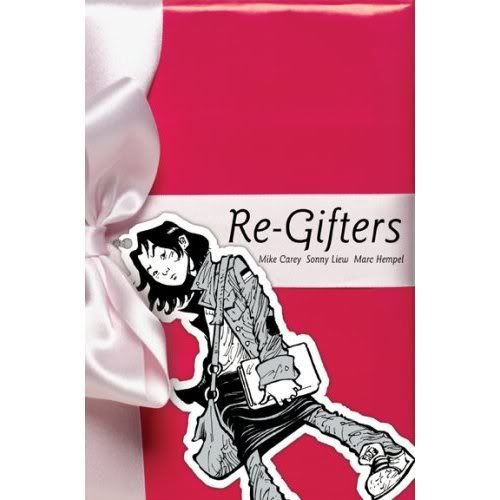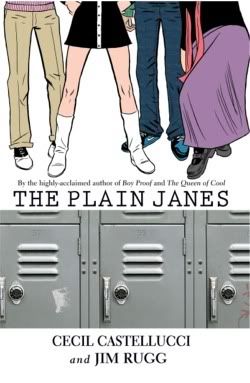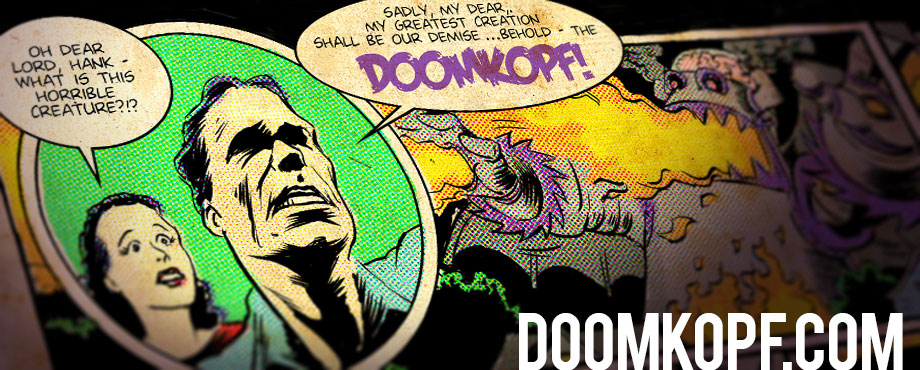Minx, the new girls club
When the folks at DC sent over two of the new books from the company’s new Minx line — which is targeted at a young, hip female audience — I wondered what would happen if the books weren’t any good. If I were inclined to give the books bad reviews, would it come across as just the crusty stick-in-the-mud not being able to step out of the perceived place of comics? Or, even worse, would I simply be a charter member of the Comics Are For Boys Club?
 Probably good for everyone then that Minx (at least from the initial offerings) is a true and pure success. Creating a line of comics marketed for the exact opposite type of person than typically reads comics (aside from a small overlap, mostly with manga) is one hell of a risk, and it has yet to be seen whether the move will be a success financially. But, at the very least, DC has created a worthwhile product and one of the best exemplars yet that comic books are a medium, not a genre.
Probably good for everyone then that Minx (at least from the initial offerings) is a true and pure success. Creating a line of comics marketed for the exact opposite type of person than typically reads comics (aside from a small overlap, mostly with manga) is one hell of a risk, and it has yet to be seen whether the move will be a success financially. But, at the very least, DC has created a worthwhile product and one of the best exemplars yet that comic books are a medium, not a genre.
The books we’re discussing here are Mike Carey’s Re-Gifters and The Plain Janes ($9.99 each). Both are slim and sized similar to manga titles. I can’t help but wonder if the design is intentionally structured in the way of those quick-read adolescent girl adventures of yesteryear like The Babysitters Club, et al. The books share several traits (as they do with all Minx books, judging from previews): the main character is a bull-headed teenage girl seeking her place in the world, boys are a major but not life-altering concern, their families are supporting but lack understanding of their problems, and some challenge must be bested by the book’s end. These are fairly generic, yes, but they’re distinctive enough to clearly delineate the target audience.
In case it is not clear, I am not the target audience. I am a guy. My chief concern in high school was being a chubby nerd, and that was years ago. I did not like boys. My main concern going into these books was whether they would be remotely accessible for those outside the demographic. The fact that they are so accessible, then, is their truest success. These are good books first and foremost. They’re good books for girls second.
I’ll start with Re-Gifters. It’s main character, Dixie, is a Korean-American teen who is simultaneously trying to win a martial arts tournament, woo a boy and rediscover her “Ki” (think The Force). That the book does such an effective job of capturing the teenage voice (and concerns) is a credit to Mike Carey and how versatile a writer he is. While this story is a bit of a retread (it apes the plot of pretty much every sports movie ever made), the successes come in the nuances of the characters and how they become more and more unique as the story progresses. While I liked the re-gifting subplot, it seems like a strange way to title the book (and brand it), since it’s such a minor aspect.
The art is a bit “kiddy,” though not unbearably so. It really worked in parts and wasn’t nearly as good in others. It might just be that the small-dimension pages are a bit too tight and the scratchy inks lose their impact when dialed down too far. In fact, after giving it another look, I do think that’s the case.
 If Re-Gifters is good, then The Plain Janes is great. In fact, it’s easily up there on my early list of favorite graphic novels of the year. This book is extremely well done top to bottom, to the point that I’m forced to scrape to find the most measely criticism: I wish it was longer. But we’ll get to that in a minute.
If Re-Gifters is good, then The Plain Janes is great. In fact, it’s easily up there on my early list of favorite graphic novels of the year. This book is extremely well done top to bottom, to the point that I’m forced to scrape to find the most measely criticism: I wish it was longer. But we’ll get to that in a minute.
Janes follows Jane (go figure), starting with her almost dying in a bombing in “Metro City.” I was on edge from this dubious beginning, with the ridiculously named city and unrealistic explosion (strangely depicted without violence). And then the real story began, and I realized that setup is just setup, a means to enter a world a bit off from our own, an entry point into a life worth viewing. So then, Jane.
A former it girl in her high school, blonde and pretty, Jane hacks off her hair and dyes it dark. She finds art and revels in newfound creativity. And then her parents, terrified of what almost was, pack her up and move out to the ‘burbs, where life is boring and Jane’s joie de vivre is stifled. Given the chance to rejoin the preppies, Jane instead lands with a bunch of other girls named Jane (or Jayne), who are all unpopular. Together, they create a sort of art attack squad, going all Banksy on Boringville.
Through each of the Janes, writer Cecil Castellucci shows a different way that high school can inhibit its most creative students, and the town’s response to the art reveals the adults for their lack of fun. And while those are on the surface the major contentions of the plot, Castellucci (author of Boy Proof, which I haven’t read) squints into the minutae of interpersonal relationships (mostly between the Janes) and how the main Jane silently grieves to deliver an undertone of human spirit battling ennui that mirrors the surface plot. The book is rife with starkly touching moments, usually coming when things are at the most quiet. It is a sly and memorable story that takes on the genre of Mean Girls and makes something entirely new, and much better.
The editors at Minx did an exceptional job in finding artist Jim Rugg and attaching him to the book. Rugg’s somewhat simple black and white work is reminiscent of much of what you see in indie comics, but I’m not sure if I’ve ever seen someone with a better mastery of facial expressions. The subtleties of Castellucci’s writing wouldn’t have worked if not for Rugg’s ability to ascribe the perfect emotions. And while many panels are close-ups that allow for greater expressiveness, he manages to bring alive even the panels filled with people.
So, that little problem? There are a few subplots (most notably the mental struggles of Jane’s mom) that aren’t tied up, and it seems just a few more pages would’ve sufficed. Also, some of the personal developments have to occur in hypertime to keep within the pagecount. But the lack of a perfectly clean ending may have been intended, since the book does focus so much on the imperfections of life and our calling to tackle them. Take John Doe, the young man injured in the bomb blast who Jane becomes somewhat obsessed with, though he remains in a coma. His subplot remains wide open as the book ends, an intended effect to leave the reader wanting more.
And, corny as it is to say, that’s the feeling I have after looking over these first two books from Minx.
